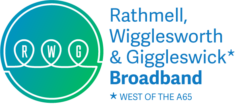LEWFA welcomed a group of us on the 25th June, and talked us through their experiences so far with their B4RN project, which was started in 2015 and was, when we met them, a little over a month into the digging and laying of the fibre optic cables for their community broadband network.
The meeting was extremely helpful, and painted a realistic and positive picture of the organisation, investment, determination and effort required to carry out a community project of this type.
Key points:
- LEWFA expect the whole project to take 2 years, from start to finish.
- They identified three key ongoing tasks and allocated each one to a member of the LEWFA team, so that the workload would be manageable. The tasks were:
- promotion of the project and communication of progress within the community
- route and network planning
- fundraising and finance
- All three of those tasks, running in parallel, were essential to get the project with B4RN started: local enthusiasm was raised and gauged by talking to households and neighbours about the idea; those interested were then asked how much they might roughly be willing to invest in the project (for more on why this community investment is key to all B4RN projects, see here); an initial network map covering all properties in the 5 villages allowed B4RN to calculate an approximate cost for the LEWFA project, to check that the cost wasn’t likely to be in excess of what the community was prepared to pay for it.
- Money was only asked for when LEWFA were sure that the cost was within the community’s reach. When enough money had come in for LEWFA to be sure that the project would be successfully funded, they gave the go-ahead and work started in earnest… ie, material was ordered and digging started.
- Members of the community signed up for smaller / shorter roles in the project, such as talking to landowners to agree wayleaves for the cable to go under their fields, or co-ordinating the digging with landowners, farmers, contractors and volunteers, or helping on dig days (whether with preparation, digging under walls, feeding cable through the mole plough and so on… or with sandwiches, tea and moral support).
- Almost all landowners in the LEWFA area have been extremely supportive of the project, and getting their permission for cable to run under their land has been relatively straightforward, with few exceptions. This is a key factor in the success (and in limiting the cost) of a B4RN project; landowners need to see and be sympathetic to the benefits of bringing broadband to their wider community, since they aren’t paid for cable crossing their land (though they can be “paid” for digging in the cables themselves).
In summary, LEWFA were enthusiastic about their project, and happy with their experience with B4RN so far. Their advice and experience (which they were very willing to share with us, and which we were very grateful to receive) gave those of us from Rathmell and Wigglesworth considerable hope that a similar project could work well in our villages.
Thanks again to LEWFA for their hospitality and openness.
